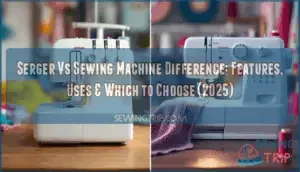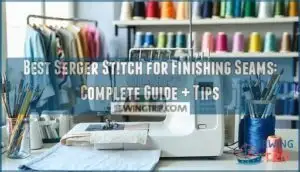This site is supported by our readers. We may earn a commission, at no cost to you, if you purchase through links.
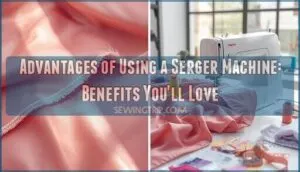
Your regular sewing machine manages most jobs well enough, but those raw edges inside your garments tell a different story. They fray with each wash, pucker on stretch fabrics, and generally look homemade rather than professionally finished. That’s where a serger changes everything.
This specialized machine doesn’t just sew—it simultaneously stitches, trims, and encases raw edges in one smooth pass, creating those clean finishes you see inside store-bought clothes.
The advantages of using a serger machine extend far beyond prettier seams, though. From preventing fabric fraying to conquering stretchy knits that make standard machines cry, a serger turns frustrating sewing challenges into straightforward tasks.
Whether you’re hemming delicate silks or constructing activewear that needs to move with the body, these machines deliver professional results that hold up beautifully over time.
Table Of Contents
- Key Takeaways
- Key Benefits of Using a Serger Machine
- Faster Sewing and Increased Productivity
- Superior Performance With Stretch Fabrics
- Creative Stitching and Decorative Options
- Clean and Polished Edges Every Time
- Increased Versatility for Sewing Projects
- Essential Features That Elevate Sewing
- Maintenance and Longevity Advantages
- Top Serger Machines and Accessories
- Frequently Asked Questions (FAQs)
- Conclusion
Key Takeaways
- A serger simultaneously stitches, trims, and encases raw edges in one pass, delivering factory-quality finishes that prevent fraying by up to 80% compared to zigzag stitching while dramatically reducing construction time.
- The machine excels with stretchy fabrics by using 3-5 interlocking threads and differential feed settings, creating seams that stretch 50-70% without breaking—essential for activewear and knits that cause regular machines to struggle.
- Beyond basic seaming, sergers unlock creative techniques like rolled hems, lettuce edges, and automatic gathering while handling everything from delicate chiffon to heavy denim through simple tension and feed adjustments.
- Built-in cutting blades and high-speed operation (up to 1,500 stitches per minute for home models) mean you’ll finish projects faster with consistent, professional results that hold up beautifully through repeated washing and wear.
Key Benefits of Using a Serger Machine
If you’ve been sewing for a while, you know that finishing seams can feel like a chore—but a serger changes that completely. This machine delivers clean, professional results that make your projects look store-bought, not homemade.
Let’s walk through the key benefits that make a serger worth adding to your sewing space.
Professional-Quality Seam Finishes
When you want factory-grade seams without sending your project to a manufacturer, a serger delivers that retail garmenting quality right at home. Here’s why professional finish matters:
- Consistent edges eliminate the uneven look of zigzag stitching
- Seam uniformity matches what you see in store-bought garments
- Textile finishing happens in one smooth pass
- Finishing edges stay flat and secure through countless washes
- Appearance maintenance keeps your work looking polished for years
Sergers are especially helpful for sewing stretchy knits. Your seam finishing instantly levels up.
Prevention of Fabric Fraying
Professional seam finishing naturally leads to one of the serger’s standout benefits: stopping fabric fraying. When you work with a serger, the machine cuts and overlocks edges simultaneously, creating a fray-resistant barrier that zigzag stitches can’t match. One popular technique is to use pinking shears first to further reduce fraying.
Industry user data shows serger stitch types reduce fraying by up to 80% compared to standard finishing edges, especially important for fabrics with high fray susceptibility like cotton and loosely woven materials.
Enhanced Stitch Durability
Beyond stopping frays, sergers deliver stitch durability that outlasts traditional machines. You’ll notice seams hold up better through repeated washing and wear because sergers use three to five threads in a looped configuration.
That means enhanced wear resistance and flexibility—especially important for knits. Four-thread overlock stitches distribute tension evenly, preventing seam popping and maintaining professional finish quality even under stress. Your garments simply last longer.
Four-thread overlock stitches distribute tension evenly, preventing seam popping and delivering enhanced wear resistance that makes your garments last longer
Versatility Across Fabrics
Sergers adapt to nearly any fabric—knit fabrics, stretchy fabrics, delicate materials, even heavy fabrics like denim. Their differential feed settings prevent puckering on silks and stretching on jerseys, while specialized models handle multi-layer fabrics with ease.
This fabric handling flexibility means you’re not limited by fabric types or fabric selection, opening up endless stitch capabilities for garments, home décor, and creative projects alike.
Faster Sewing and Increased Productivity
When you’re working on a sewing project, time matters—and that’s where a serger really shines. These machines are built to work faster and smarter than traditional sewing machines, handling multiple tasks at once without breaking a sweat.
Let’s look at how a serger can seriously boost your productivity and cut down your sewing time.
Simultaneous Stitching, Trimming, and Finishing
Think of it like an assembly line in your sewing room—your serger performs stitching, fabric trimming, and edge finishing all at once. This three-in-one approach delivers serious time savings while ensuring quality improvement across projects.
You’ll appreciate the user convenience of overlocking without switching tools, and the operational features mean you get a professional finish with excellent sewing efficiency.
It’s fabric versatility at its finest, no matter what you’re creating.
High-Speed Operation Compared to Standard Machines
When you compare a serger to your standard sewing machine, the speed vs. quality difference is striking—sergers deliver faster sewing at up to 1,500 stitches per minute for home sergers and an impressive 10,200 for industrial applications.
This productivity boost doesn’t sacrifice stitch consistency either. Overlocking at high speeds means you’ll finish seams with exceptional sewing efficiency, making serging a revelation for any project.
Streamlined Garment Construction
When you’re ready to cut assembly time in half, a serger transforms garment construction into a well-organized process. Thanks to automated tension adjustment and high-speed stitching, you’ll breeze through projects with one-pass finishing that eliminates extra seam reinforcement steps.
This sewing efficiency means faster sewing without sacrificing that professional finish—your workflow becomes smoother, and your results consistently impress.
Superior Performance With Stretch Fabrics
If you’ve ever tried sewing knits or spandex on a regular machine, you know the struggle is real—puckered seams, stretched-out fabric, and stitches that pop the first time you move. That’s where a serger really shines, giving you the kind of stretch and strength that stretchy fabrics desperately need.
Let’s look at why sergers handle these tricky materials so much better than standard machines.
Reliable Seams for Knits and Spandex
When sewing knits and stretchy fabrics, you’ll notice your serger delivers seam strength that holds up beautifully—often reaching 60% to 90% efficiency in knit garments. The differential feed setting prevents popping and puckering, especially critical for spandex blends.
Seam appearance stays clean and flat, without the grinning or bulk you’d see with regular machines. Motion durability? Your seams stay intact through repeated stretching and wear.
Flexibility and Strength in Stretchy Materials
Your serger manages stretchy fabrics with impressive seam elongation—up to 50-70% fabric stretch without thread breakage. The differential feed mechanism keeps seams flexible and even, while thread durability from polyester options ensures elastic recovery stays strong through repeated wear.
Stitch strength improves dramatically with proper thread selection, reducing failures by 30% in knit fabrics and garment sewing projects where flexibility matters most.
Preventing Seam Popping in Activewear
When you’re working with activewear, seam popping isn’t just annoying—it’s a project killer. Your serger’s overlock stitches deliver stretch seam durability that moves with the body, preventing embarrassing wardrobe malfunctions during yoga or running.
Here’s why serger stitch density matters for activewear seam construction:
- Flexible seams adapt to negative ease in leggings and sports tops
- Excellent fabric/seam compatibility works with spandex and polyester blends effortlessly
- Reduced seam slippage in knit fabrics compared to zigzag stitches
- Enhanced seam performance outcomes through multiple interlocking threads
- Professional activewear sewing results that withstand repeated washing and intense wear
Your garment sewing projects gain confidence-inspiring strength when working with stretchy fabrics.
Creative Stitching and Decorative Options
A serger isn’t just about practical seam finishing—it opens up a world of creative possibilities you won’t get with a regular sewing machine. From delicate rolled hems on formal wear to playful decorative edges, your serger can add that professional polish and artistic flair to your projects.
Let’s explore three standout techniques that’ll transform how you think about finishing your garments.
Rolled Hems for Elegant Finishes
When you want that couture detail on lightweight fabrics, rolled hems deliver a narrow, polished edge that transforms napkins, scarves, and dress hems into something special. The serger encases the raw edge completely, preventing frays and boosting edge durability. Adjusting tension controls lets you tailor the finish to your fabric’s weight, while decorative threads add sheen or texture. It’s fabric compatibility and professional finishes rolled into one technique.
| Fabric Type | Rolled Hem Advantage |
|---|---|
| Silk & Chiffon | Clean edge with no fraying |
| Rayon & Georgette | Elegant, professional finish |
| Lightweight Knits | Secure, durable hem |
Decorative Edges and Lettuce Hems
Beyond refined rolled hems, you can achieve playful lettuce edges by gently stretching knit fabric as your serger runs—creating those signature wavy ripples on t-shirts and scarves.
This creative stitching relies on tension adjustments and proper needle selection for ideal stitch density. The serger trims fabric trimmings automatically while forming decorative edges that resist fraying, giving your projects edge durability and a professional finish without extra steps.
Gathering and Ruffling Capabilities
You can also gather and ruffle fabric beautifully with your serger’s Differential Feed and Gathering Foot attachments. Adjusting settings delivers Precision Adjustability—reducing fabric up to 50% while finishing edges simultaneously.
This sewing technique saves Time Efficiency, cutting labor by 60% compared to basting.
Whether you’re working with chiffon or denim, these Fabric Application methods and sewing tips guarantee a professional finish across every project.
Clean and Polished Edges Every Time
One of the biggest perks of using a serger is the way it manages fabric edges—clean, neat, and completely professional. You won’t have to worry about uneven trims or raggedy seams when you’ve got the right features working in your favor.
Let’s look at three key elements that make this precision possible every single time.
Built-in Cutting Blades for Consistent Trimming
One of the best perks of serging is how those built-in cutting blades trim your fabric edges automatically as you stitch. Sharp blades prevent fabric fraying and deliver that professional finish you’re after.
You’ll get consistent trimming precision every single pass, which means uniform seam allowances without any extra effort.
Just remember, blade maintenance matters—dull blades stretch fabric and compromise your edge quality.
Adjustable Stitch Width and Length
When you fine-tune stitch width and length on your serger, you’re taking control over seam appearance, fabric handling, and stitch strength all at once. Shorter lengths create denser stitches for enhanced stitch quality and durability, while width adjustments position your edges perfectly for clean finishing.
This control boosts sewing efficiency, whether you’re tackling decorative stitching or everyday seams, giving you professional results every time.
Seam Allowance Precision
Precision matters when you need consistent seams. Your serger’s throat plate and seam guides help maintain accurate blade-edge distance as you align fabric edges.
Testing on scrap fabric before starting confirms your settings deliver the seam allowance precision you want. This attention to fabric alignment translates directly into professional finishing and excellent stitch quality on every project you create.
Increased Versatility for Sewing Projects
One of the best things about a serger is how it opens up your creative possibilities across different types of projects. You’re not limited to just garments or just home décor—you can tackle both with confidence, along with accessories and more.
Let’s look at the ways a serger is suitable for whatever you want to create.
Garments, Home Décor, and Accessories
You’ll discover a serger truly shines when you move beyond garments into home decor sewing and accessories. Those professional finishing touches you’ll create—think napkin edges, pillow seams, and scarf hems—rival boutique quality.
Your fabric selection opens up dramatically, too, since sergers handle everything with consistent seam finishes. From curtains to tote bags, your customization options and embellishment techniques expand beautifully with this adaptable tool.
Handling Delicate and Heavy Fabrics
Whether you’re sewing with gossamer chiffon or rugged denim, your serger adapts beautifully through differential feed adjustments and proper thread tension settings. Needle selection matters tremendously—fine needles prevent snagging delicate fabric types, while heavy-duty options power through thick layers.
You’ll achieve impressive seam finishes across the spectrum, from nearly invisible hems on silk to sturdy stitching on canvas, making fabric handling remarkably adaptable for any sewing project.
One-Pass Finishing for Complex Designs
Complex garments with intricate seamwork become far more manageable when your serger takes care of trimming, stitching, and fabric finishing simultaneously. This design efficiency cuts construction time by up to 72%, while maintaining quality control standards that rival professional manufacturers.
You’ll appreciate these productivity gains:
- Pleats and gathers stay consistent without puckering
- Curved seams finish cleanly in one pass
- Labor reduction frees you for creative decisions
- Fabric versatility across delicate and heavy textiles
- Decorative edges boost visual interest instantly
Essential Features That Elevate Sewing
A serger isn’t just about speed—it’s packed with features that make your sewing life easier and your results look better. From multiple threads working together to smart functions, these machines are designed with real sewers in mind.
They take the guesswork out of setup, offering key features that’ll change how you approach every project.
Multiple Thread Use for Stronger Seams
When your serger uses multiple threads—usually three to five, you’re building seams that can handle serious stress. This multi-thread approach boosts stitch quality and thread durability, reducing seam slippage by up to 60% compared to basic stitching.
For industrial applications and production efficiency, that means fewer defects and stronger finishes. Your overlock machine isn’t just serging; it’s weaving resilience into every seam with greater fabric adaptability.
Auto-Threading and User-Friendly Functions
Air-threading systems eliminate threading frustrations you don’t need. Models from Juki and Janome thread both loopers in about one second—versus 10 to 15 minutes manually. That’s a 90% reduction in threading time and near-total error reduction for beginners.
- Beginner accessibility: Start complex projects without anxiety
- Seam consistency: Perfect threading path every single time
- Market accessibility: Entry-level autothreading sergers now priced $900–$1,500
Less serger maintenance stress, more sewing machine joy.
Adjustable Tension for Various Fabrics
Once your serger threads itself, you still need proper tension for every fabric type. Tension discs control how tight or loose each thread pulls—critical for stitch quality. Dial tension down for chiffon, up for denim.
When balanced correctly, your seams stay durable across fabric weight variations, from stretchy fabrics to canvas. Poor tension? Expect loops, puckering, or thread breakage.
Mastering tension troubleshooting and thread compatibility transforms stitch appearance instantly.
Maintenance and Longevity Advantages
Your serger won’t just transform your sewing projects—it’ll stick around for the long haul if you treat it right. Unlike more delicate machines, sergers are built to handle frequent use, but a little regular care goes a long way in keeping them running smoothly.
Here’s what you need to know about maintaining your serger and maximizing its lifespan.
Easy Cleaning and Lint Removal
One of the nicest surprises about owning a serger is how straightforward cleaning and lint removal can be. Modern sergers feature removable side panels and tool-friendly access points, making regular maintenance a breeze rather than a chore.
- Use brushes, tweezers, or canned air to clear lint from loopers and cutting blades after each project
- Vacuum attachments reach hard-to-access areas, removing up to 94% of visible debris
- Clean tension disks monthly with a damp Q-tip to prevent stitch inconsistencies
- Follow manufacturer schedules to reduce machine downtime by nearly half over time
Regular attention to lint removal tools and cleaning frequency directly impacts your serger’s machine lifespan. Studies show that consistent user methods—like brushing after every sewing session—can extend operational life considerably. Plus, design enhancements in newer sewing machines, such as integrated lint collectors and quick-release covers, make upkeep even simpler. Treat your sewing tools and sewing accessories with care, and your serging experience stays smooth and productive for years.
Durable Components for Frequent Use
Beyond easy cleanup, your overlock machine is engineered for the long haul. Heavy-duty sergers feature metal frames and heat-resistant internal parts that deliver consistent stitch quality even at high speeds—industrial models handle up to 10,200 stitches per minute.
Engineering advances like poly core threads and precision steel components boost material endurance, while industry standards guarantee machines meet rigorous testing for component lifespan and maintenance impact in demanding serging environments.
Tips for Prolonging Serger Lifespan
To extend your serger’s lifespan, start with lint removal after every project—cut edges generate more debris than standard sewing machines. Check your manual for proper lubrication guidelines, since not all models need oiling.
Schedule professional servicing annually, or every six months if you sew daily. Master correct usage and threading to prevent 45% more mechanical faults, and explore predictive maintenance tools that flag issues early.
Top Serger Machines and Accessories
Once you’ve experienced the benefits of using a serger, you’ll want to pair it with the right tools and accessories to improve your results.
Choosing quality machines and supplies can make a real difference in how smoothly your projects come together. Here are some top-rated serger machines and helpful accessories worth considering for your sewing setup.
1. JUKI Portable Thread Serger Sewing Machine
If you’re after portable serger benefits without compromising performance, the JUKI Portable Thread Serger is a solid choice. Threading ease comes naturally with color-coded guides and a breakaway looper that gets you sewing in seconds.
This overlock machine accommodates 2, 3, or 4 thread configurations, offering fabric versatility from delicate silks to heavy denim. You’ll appreciate the sewing precision from its 1,500-stitch-per-minute speed and adjustable differential feed.
Safety features include a swing-cover switch, while serging techniques are simplified through clear controls—perfect for mastering professional finishes at home.
Best For: Sewers who want a fast, reliable serger that’s easy to thread and portable enough to move between workspaces while handling everything from lightweight knits to heavyweight fabrics.
- Color-coded threading with breakaway looper makes setup quick and nearly foolproof, even for beginners.
- Speeds up to 1,500 stitches per minute with adjustable differential feed and cutting width for professional results on any fabric type.
- Compact and portable design with a safety switch that prevents operation when the cover is open.
- No coverstitch or coverhem capability, so you’ll need a separate machine for those finishes.
- Instruction manual doesn’t cover all stitch possibilities in detail, which might leave you searching for extra resources.
- Requires a step-down transformer if you’re in a country with 220V power, adding an extra purchase and setup step.
2. Juki MO-1000 Air Threading Serger
Threading frustration disappears with the Juki MO-1000‘s air threading system—it manages both loopers in under 3 seconds. This overlock machine delivers superb stitch quality at 1,500 stitches per minute, while user ergonomics shine through its spacious throat area and whisper-quiet operation.
Versatility enhanced by 2/3/4-thread conversion lets you tackle everything from chiffon to denim without needle changes. Maintenance needs stay minimal thanks to accessible looper areas and durable blades rated for 100,000 cuts.
It’s serging techniques made simple, rivaling even the popular Juki MO654DE.
Best For: Sewers who want professional-grade serging without the threading headaches—ideal for both beginners tackling their first projects and experienced users churning out high-volume garment work.
- Air threading system eliminates the usual looper frustration, getting you from thread spool to ready-to-sew in seconds instead of the usual 10-minute struggle.
- Handles the full fabric spectrum without fussing—chiffon, denim, tulle, knits—all with consistently clean edges at a blazing 1,500 stitches per minute.
- Roomier workspace and quieter operation than typical sergers make long sewing sessions actually enjoyable instead of cramped and headache-inducing.
- Some users report the air threading can be temperamental or stop working entirely, which defeats its main selling point.
- Manual threading the needles still requires patience even with the automatic threader, and the instruction manual’s multi-language layout doesn’t help.
- Needs regular cleaning to prevent thread jams, and a few buyers experienced durability issues that required repairs or returns.
3. Serger Sewing Quick and Easy Projects
This beginner-friendly guide unlocks your serger’s full potential with 15 hands-on projects that build real confidence. From fast napkin making (under 15 minutes) to scrunchie production (less than an hour), you’ll master essential serging techniques.
Explore projects like table runner assembly and quilt-as-you-go techniques, which cut traditional quilting time in half. Create practical items such as serger shoelaces and twisted headbands while learning serging and overlocking.
It’s the perfect companion for anyone ready to move beyond basic sewing with a serger.
Best For: Beginners eager to learn serger basics through quick, practical projects like napkins, scrunchies, and placemats that take 15 minutes to 2 hours each.
- Teaches serging step-by-step with 15 beginner-friendly projects that build confidence fast—most items finish in under an hour.
- Cuts project time dramatically compared to traditional methods (table runners in 2 hours vs. hand quilting, napkins in 15 minutes).
- Covers versatile techniques from fashion accessories to home décor, with projects optimized for scrap fabric and minimal waste.
- Some projects require specific serger features like coverstitching that not all machines have, limiting usability.
- Published in 2008, so certain projects may feel dated or too simple for experienced sewers.
- Users without advanced serger capabilities might find several projects unusable, potentially reducing the book’s overall value.
4. Sew Your Own Pet Pillows Book
You’ll find twelve adorable pillow pet patterns in this Design Originals guide, perfect for transforming your serger skills into cuddly creations. Whether you’re working on dogs, cats, or bears, the step-by-step photos make even complex sewing projects approachable.
The book covers various skill level applicability—about 60% suits beginners, while others help you advance. Educational features include troubleshooting tips and machine settings guidance.
With reader project outcomes showing most completing three pillows within a month, it’s a practical addition to your sewing tools. Commercial availability runs $9.99–$12.50 at major craft retailers.
Best For: Sewing enthusiasts of any skill level who want to create cute, functional animal pillows for home décor, gifts, or donation projects.
- Includes 12 different animal patterns with step-by-step photos and clear instructions that make projects approachable even for beginners.
- Affordable at $9.99–$12.50 and works with standard fabric amounts (typically under one yard per project), keeping costs reasonable.
- Strong community engagement with active online groups, sew-alongs, and high completion rates—most readers finish three pillows within a month.
- Patterns require enlarging 250% to actual size, which can be expensive and inconvenient at copy shops.
- Mixed reviews on pattern usability, with some customers finding the sizing adjustments difficult to work with.
- Only 20 pages long, which may feel limited for the price compared to other sewing project books.
5. Tortoise All Purpose Serger Sewing Thread
Think of quality thread as the foundation of every strong seam. Tortoise All Purpose Serger Sewing Thread delivers exactly that—100% polyester composition engineered for serging and overlocking at speeds up to 1,200 stitches per minute.
Each 3,000-yard spool means fewer interruptions during projects, while the 40S/2 specification ensures consistent seam strength across lightweight and midweight fabrics.
Machine compatibility spans most serger brands, and the economic value shines with bulk packaging reducing your cost per yard. With proper thread maintenance, you’ll notice less lint buildup and smoother operation—essential sewing tools for any serious sewist.
Best For: Sewists running high-volume serging projects who need reliable, cost-effective thread that handles high speeds without constant spool changes.
- Each 3,000-yard spool dramatically reduces mid-project thread changes, keeping you in your workflow longer without interruptions.
- 100% polyester construction resists fading, UV damage, and abrasion better than cotton alternatives, so your seams stay strong through repeated washing.
- Works smoothly across most serger brands at speeds up to 1,200 stitches per minute, with less lint buildup that would otherwise require frequent machine cleaning.
- Some users report inconsistent thread thickness that can affect stitch quality and tension settings during use.
- Thread strength gets mixed reviews, with occasional breakage reported even during normal sewing conditions.
- Color matching can be hit-or-miss if you need precise shade coordination across multiple spools or projects.
6. Portable Sewing Kit Emergency Mending Supplies
Even the best serger can’t fix wardrobe malfunctions when you’re miles from home. That’s where a portable sewing kit becomes your backup plan.
The Coquimbo Emergency Mending Kit packs 27 essentials—thread, needles, scissors, buttons, and a seam ripper—into a compact 5.63 x 4.53-inch case weighing just 5 ounces. Perfect for travel mending or quick DIY repairs, these kit essentials handle multiple fabric types on the go.
While kit durability varies with cheaper thread and needles, it’s still smart insurance for unexpected tears and missing buttons.
Best For: Travelers, campers, and anyone who needs quick clothing fixes away from home—especially if you’re prone to wardrobe emergencies on the road.
- Compact and lightweight at just 5 ounces, so it fits easily in luggage, backpacks, or glove compartments without taking up precious space.
- Includes 27 essential tools in one kit—thread, needles, scissors, buttons, measuring tape, and more—covering most basic mending needs.
- Affordable backup solution for emergency repairs like replacing buttons, fixing hems, or mending small tears when you’re traveling.
- Thread quality is reportedly poor and breaks easily, which can be frustrating during repairs.
- Needles and scissors may lack durability—some users report breakage after limited use.
- Limited thread colors and quantities mean you might not have the right match for all fabric types or larger projects.
Frequently Asked Questions (FAQs)
Can a serger replace a regular sewing machine?
While a serger isn’t a jack-of-all-trades replacement, it can’t handle zipper application, buttonholes, quilting abilities, or decorative stitches.
Sewing machines and serging machines work best as complementary tools for different tasks.
How difficult is it to thread a serger?
Threading difficulty varies—manual sergers take beginners 5-10 minutes using color-coded guides, while air-jet threading models finish in under a minute.
Tension adjustments and re-threading frequency improve with practice, making serging techniques more accessible over time.
What is the average cost of a serger?
A quality machine starts around $200 to $400 for entry-level pricing, while mid-range costs stretch between $400 and $1, High-end models from brands like Baby Lock or Bernina can exceed $3,
Do sergers work well with sheer or lightweight fabrics?
Yes, sergers handle sheer fabric beautifully when you adjust tension balance and stitch settings for delicate edges.
Using a stabilizer prevents seam puckering during finishing, so your lightweight weaving stays smooth without fraying.
Can beginners learn to use a serger effectively?
Absolutely—though threading difficulty might seem intimidating at first, over 70% of beginners gain solid serging skills within three weeks.
Video tutorials, stitch practice, and project confidence build quickly, making serger sewing for beginners surprisingly achievable with beginner tips.
Conclusion
Picture Sarah, who spent years avoiding knit projects because her regular machine turned stretchy fabric into puckered nightmares. One serger later, she’s confidently constructing yoga pants with seams that flex and hold.
That’s the real magic here—the advantages of using a serger machine transform those “I can’t sew that” moments into “watch what I just made” victories. Your projects deserve finishes that look as good inside as they do outside.
- https://www.youtube.com/watch?v=pz2GjZo3pbg
- https://www.longsew.com/be/news/whatdoessergermachinedo-4078.html
- https://marketintelo.com/report/serger-machine-market/amp
- https://www.threadsmagazine.com/2022/04/04/what-kind-of-serger-is-right-for-you
- https://growthmarketreports.com/report/serger-machine-market

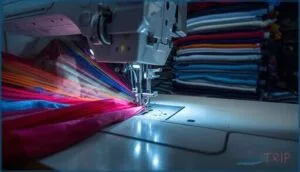
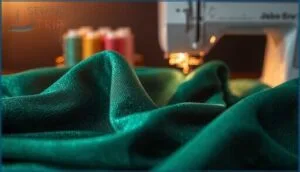
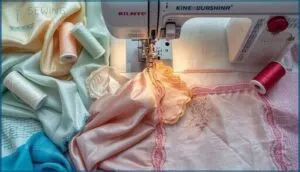
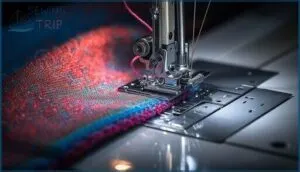
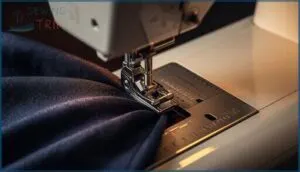
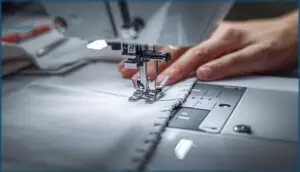


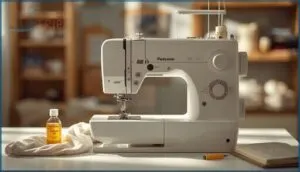
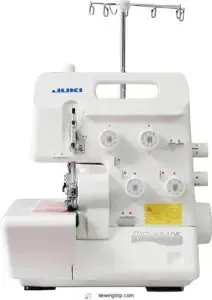
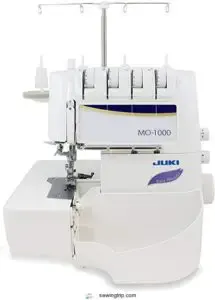
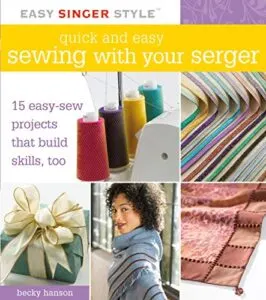



![Sewing Machine Vs Serger Difference: Which Do You Need? [2025] 7 sewing machine vs serger difference](https://sewingtrip.com/wp-content/uploads/2025/09/sewing-machine-vs-serger-difference-300x172.jpg.webp)
